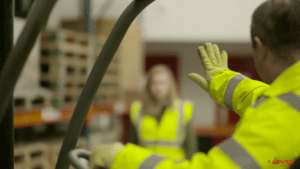The number of serious injuries involving forklift trucks has soared by almost a third in the last year, according to one expert in the field.
 Speaking at Safety & Health Expo, Mentor FLT Training’s Technical Manager Andy Cartwright said despite “stringent legislation”, the number of injuries has risen from 1,000 to 1,300 in the last 12 months.
Speaking at Safety & Health Expo, Mentor FLT Training’s Technical Manager Andy Cartwright said despite “stringent legislation”, the number of injuries has risen from 1,000 to 1,300 in the last 12 months.
In addition, he told the event there have been 5,700 RIDDORs and 12 fatalities all put down to forklift trucks in the last two years and approximately five people are hospitalised every single day with life-changing injuries through accidents related to forklifts.
But he added that more than half (57%) of those injured by forklift trucks are pedestrians, although that number does include drivers who have stepped down from the vehicle and onto the ground floor.
In his presentation, Mr Cartwright talked about the key factors to prevent forklift accidents.
In particular, he said operator training was key, but there were three stages to training – basic, specific job and familiarisation training.
He said it was important to show people how to load and unload, and show operators around the site properly, highlighting blind corners.
“New starters in the first six months are more at risk of having an accident, because they are not used to the site or traffic systems,” he told delegates.
He said it was also important to maintain safe distances between vehicles and pedestrians onsite.
Safe distances
 “If we want someone to operate a forklift truck, we send them on a course,” he added. “But what kind of training do you give your other staff about fork lift awareness, how close can they get to them? You need to look at pedestrian awareness and that includes everyone on your site, including visitors that come on your site.”
“If we want someone to operate a forklift truck, we send them on a course,” he added. “But what kind of training do you give your other staff about fork lift awareness, how close can they get to them? You need to look at pedestrian awareness and that includes everyone on your site, including visitors that come on your site.”
Mr Cartwright also spoke about how work targets can create accidents.
“I’ve worked for a number of distribution companies and supermarkets, and they all set deadlines for goods coming out and for goods coming in. Does this force the individual to rush around on his forklift? Are the targets realistic? If the individual is rushing and they drop a palette of goods, how much will that cost you? What has happened to your timescales then?”
He also talked about whether companies have suitable equipment for the task itself and whether the correct policies and procedures are in place.
“Have you carried out risk assessments and have they been made available to the people carrying out the task?” he said.
“There are so many sites that I’ve been to and the people have people have fulfilled their legal obligation, done a risk assessment and it’s been put in a filing cabinet or the company intranet. You talk to the person operating the equipment and have they never read it?”
“To reduce risk, you need to ensure that policies are in place and they are communicated and that people understand what you want them to do.”
He added that forklift operators, even those with training and experience, all need to be routinely monitored and offered refreshing and retraining opportunities at regular intervals.
He also highlighted the need for companies for give proper authorisation to those who are permitted to operate forklift trucks and the need to have proper policies in place to deal with debris and rubbish on a site.
“In the UK, our approach is often based on hazard identification, hierarchy controls and policy and procedures,” he concluded.
“If the company has implementing all these points, you will reduce the chance of an accident, but there’s more you can do – and that’s having a simple understanding of human behaviour.
“In my experience, people are not trying to have accidents or injure people. So even if you have all the controls in place, who do forklift operators continue to have accidents? The human brain processes around 2 million bits of information per second. It filters out important information that we deem unnecessary and focusses instead on what we have decided is important. It does this subconsciously.
“Forklift operation is a highly repetitive task. People are driving around an environment, day in and day out. They have probably operated it incorrectly thousands of times, without any consequence. They are very familiar with the task and their brains have filtered out the information they have decided is unnecessary. Your safety measures are only as effective as those who ensure they are being followed.”
This eBook will guide you through some of the key understandings you need to be able to manage driver safety effectively and, at the end, provide a series of free resources you can access to help you ensure your own driver safety management system is robust, legally compliant and in line with industry-accepted good practice.
Download this eBook from Driving for Better Business and SHP to cover:
- Why do we need to manage driver safety?
- Duty of care – a shared responsibility;
- Setting the rules with a driving for work policy;
- Managing driver safety;
- Ensuring safe vehicles;
- Safe journeys and fitness to drive;
- Record keeping;
- Reporting;
- The business benefits of good practice;
- Additional resources

 Speaking at
Speaking at  “If we want someone to operate a forklift truck, we send them on a course,” he added. “But what kind of training do you give your other staff about fork lift awareness, how close can they get to them? You need to look at pedestrian awareness and that includes everyone on your site, including visitors that come on your site.”
“If we want someone to operate a forklift truck, we send them on a course,” he added. “But what kind of training do you give your other staff about fork lift awareness, how close can they get to them? You need to look at pedestrian awareness and that includes everyone on your site, including visitors that come on your site.”